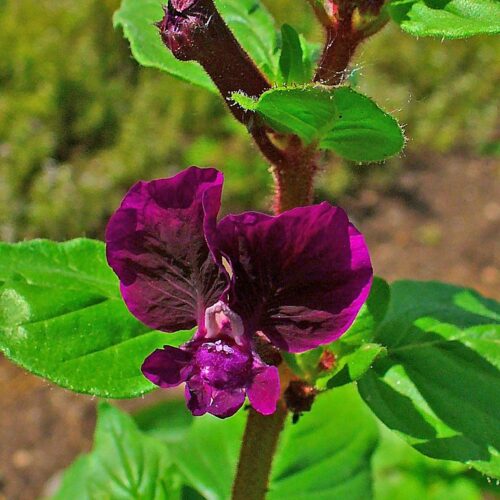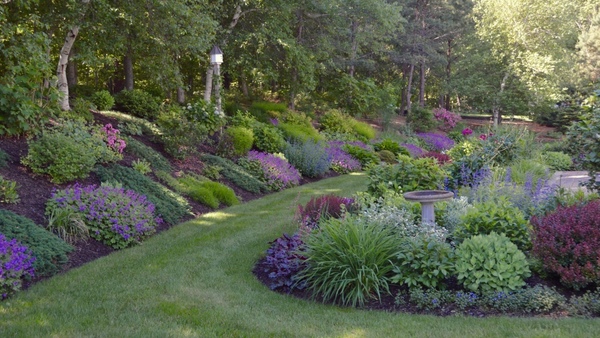
When the time came for me to transform a 90-year-old putting green into a perennial garden on my family’s three-generation plot, I froze. As a designer, I usually seek out such challenges, but when faced with planning a garden on this spot in my yard—which was a large, blank canvas—I felt overwhelmed as I could suddenly do whatever I wanted.

Step 1: Garden preplanning
Consider the space’s history and features
I’m not a big fan of themes, or of current gardening trends, for that matter. I view our entire 2 acres as a pollinator garden, and we already had dedicated spots of the yard for a crevice garden, a rock garden, an edible garden, and a meadow garden.
This new spot (once just lawn) is centrally located on our property. It acts as a central axis centered by a new gravel path that runs from the house to the end of our property.
Basic garden planning questions to ask yourself
- What is the climate of my area? This will automatically eliminate some options for you. Find your zone and region.
- What has been the natural use of this space? (A crossroads or a gathering spot should be treated differently from an area you rarely travel to. If you rarely visit that area of the yard, consider making it a more low-maintenance garden.)
- How much light does the area get? How much shade? Determine degrees of light and shade.
- What is the soil in this area like? A soil test can help.
- What plants and trees already exist in this area that provide structure and/or will need to be considered as part of the design?

Find your inspiration

I knew that color would be an essential unifying element of this new garden, but which colors? I wanted something original, so I dared myself not to limit any color and try to use all of them if I could. But don’t get me wrong, I didn’t want a rainbow garden, for that would be too easy. While I said I didn’t want a theme to follow, I did land on some guiding principles that arose after discovering a giant painter’s palette in my dad’s painting studio, complete with dried puddles of oil paint. I decided to treat color the same way it was represented on the palette, by lumping colors together by color family and then using analogous or opposite colors just as a landscape painter might. This is why I’ve called this garden the “painters garden.”
Garden planning questions to ask yourself
- What is the history of this area? Can you use that as inspiration?
- Are there any paintings, textiles, or photographs you can use for inspiration? Even a movie’s color palette could be used to help focus your design. There are many color palette finders online where you can upload images and extract the color names.
- Do you want to create a theme to this garden, such as a pollinator garden?
- Does the soil or landscape require a certain type of garden such as a shade or rock garden?

Step 2: Plant selection
Prioritize texture and form
Specific effects just work in a garden due to a plant’s unique architecture or form, as well as their texture and color. I had been playing around with height and transparency, layering tall, spiky blooms like foxgloves (Digitalis spp. and cvs., Zones 3–9) and snapdragons (Antirrhinum spp. and cvs., Zones 5–10) against clouds of perennials or annuals with smaller flowers. These particular plants can bring much value to a space. The pointillistic dots of tassel flower (Emilia coccinea, annual) can look like red-hot bits of sparks floating on long, wiry stems, for example. A garden is also much like a sculpture in that texture and form play big roles. These are all learned techniques that one acquires only by gardening and experimenting.
Garden planning questions to ask yourself
- What tall, medium, short, and ground-cover plants can I add that will fit with my theme? Learn more about planting in layers.
- What plants can I add as focal points and to provide texture?

Plant in groups where possible
I knew that scale would be in my favor. With larger spaces like this, I could follow some of the principles used in prominent English estate borders where red and pink dahlias (Dahlia spp. and cvs., Zones 8–11) work just because they are planted in gigantic groups and not just here and there in a tiny border. Numbers and volume help any color combo work, but I knew it just wasn’t as easy as that.
Garden planning questions to ask yourself
- What plants can I add to lean into a color or texture and to add mass? Learn how mass planting can work to your benefit. Hear about some of our favorite plants for massing.

Add colorful foliage to contrast bold flower colors
In the end, the real secret is foliage color, as that is the painter’s canvas. Just as the Renaissance painters often used a different color for their background canvas, so too can we. A chartreuse foliage background can save almost any garden. A yellow Asiatic lily (Lilium cvs., Zones 3–10) with a dark eye will look amazing when set against a chartreuse grass, especially if planted in bigger clumps. Let’s face it—very dark, brownish, or near-black flowers just plain disappear in a garden; set out against any glowing lime green or yellow foliage, however, they pop. Bright, jewel-toned flowers transform a space when juxtaposed with dark black foliage. Even a shrub such as a near-black ninebark (Physocarpus spp. and cvs., Zones 3–8) can tone down scorching scarlet red or flaming orange flowers, which may otherwise seem too garish.
Garden planning questions to ask yourself
- What color will my “canvas” be? What color foliage will offset the more vibrant hues? There is more than one type of green foliage for the garden.
- Can colorful foliage help to advance the color palette in the direction of my vision?

Step 3: Adapt as the garden grows
Take frequent notes and photos to help solve for problem areas
Some truths had to be accepted. Not all colors will work well together, and any color palette would probably need to change throughout the year, as plants in bloom are seasonal. Some jarring color clashes were expected (and did occur), so I kept notes.
Some notes indicated less of a particular color was needed; others indicated plants that just needed to be relocated the following spring. Taking notes does bring one more in touch with one’s garden, and rather than feeling like a failure or feeling burdened, I found myself going out every day at different times to take notes and lots of pictures of things that worked or that didn’t work.
Garden planning questions to ask yourself
- Where do I see jarring combinations?
- What can I remove? What can I move?
- Do I need to divide perennials that are taking over an area?
- Where are opportunities to create more cohesion with a complementary color?
Look for garden surprises and opportunities

The changing light in this garden came as a surprise for me, as the low sun angles in spring illuminated specific colors with nemesia (Nemesia spp. and cvs., annual), primroses (Primula spp. and cvs., Zones 3–9), and tulips (Tulipa spp. and cvs., Zones 3–8) that in July would have seemed harsh. The light through grasses in autumn inspired me to plant even more grasses than I had originally planned to.
I learned the value of those annuals and tender perennials that so many garden writers romanced about but that I never grew. Now I can’t live without the purple haze created by blue waxweed (Cuphea viscosissima, annual) in September or towering Mexican sunflowers (Tithonia rotundifolia, annual) in October. They not only fire up the evening but also attract migrating birds to their seed heads.
Garden planning questions to ask yourself
- What frustrations am I facing? What can I change to use those to my advantage?
- Are there any aspects to the design that came as nice surprises? How can I lean into those for added benefit?
- Is there a way to use the changing light through the seasons to highlight focal points or enhance the design?

Step 4: Stick with it
A new garden will teach you as it grows, as it should. And it’s OK that not every idea will work well. I discovered that mistakes not only happen but should be expected. You might be surprised that they aren’t always ugly ones. A color you dislike may suddenly work once juxtaposed against another color. Still, editing will need to be done through every season, so taking notes and plenty of pictures proves important.
For more tips on designing with color, check out:
- An Inspiring Design for Continuous Color
- Designing a Garden With Bold Colors
- Garden Design That Doesn’t Limit Your Color Palette
And for more Northeast regional reports, click here.
—Matt Mattus is the author of two books: Mastering the Art of Flower Gardening and Mastering the Art of Vegetable Gardening. He gardens in Worcester, Massachusetts.
Photos: Matt Mattus
Fine Gardening Recommended Products

SHOWA Atlas 370B Nitrile Palm Coating Gloves, Black, Medium (Pack of 12 Pairs)
Fine Gardening receives a commission for items purchased through links on this site, including Amazon Associates and other affiliate advertising programs.

Buffalo-Style Gardens: Create a Quirky, One-of-a-Kind Private Garden with Eye-Catching Designs
Fine Gardening receives a commission for items purchased through links on this site, including Amazon Associates and other affiliate advertising programs.

ARS Telescoping Long Reach Pruner
Fine Gardening receives a commission for items purchased through links on this site, including Amazon Associates and other affiliate advertising programs.



















Comments
it's beautiful! good analysis of how to use color!
Bob Ross came to mind immediately :)
how long have you been working on it?
It was built mostly in 2018 and 2019!
your blog is fantastic we need to be more informative about gardening and the value of greenery!
Log in or create an account to post a comment.
Sign up Log in